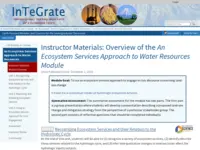https://serc.carleton.edu/integrate/teaching_materials/ecosystem_water/overview.html
Science Education Resource Center at Carleton College
This learning activity takes three 50 minute class periods.
Learn more about Teaching Climate Literacy and Energy Awareness»Grade Level
Regional Focus
Online Readiness
Topics
Climate Literacy
This Activity builds on the following concepts of Climate Literacy.
Click a topic below for supporting information, teaching ideas, and sample activities.
Energy Literacy
This Activity builds on the following concepts of Energy Literacy.
Click a topic below for supporting information, teaching ideas, and sample activities.
Notes From Our Reviewers
The CLEAN collection is hand-picked and rigorously reviewed for scientific accuracy and classroom effectiveness.
Read what our review team had to say about this resource below or learn more about
how CLEAN reviews teaching materials
Teaching Tips | Science | Pedagogy |
Technical Details
Teaching Tips
- The activities can be used as a whole module or individual activities extracted and used as free standing lessons. When used as a module, the activities scaffold learning in an appropriate and logical sequence. Quantitative components enhance the rigor, but can easily be removed.
- The module is appropriate for inclusion in a geoscience curriculum within a surface water, human impact, land use or other similar unit of study. Assessments ideas are included.
- Check out the Instructor Stories and the "Adapting InTeGrate modules and courses for your classroom" webpage.
About the Content
- The module is split into three units that focus on using an ecosystem services approach to engage in civic discourse concerning land-use change.
- Students will learn about ecosystem services, especially related to the hydrologic cycle, and infer the ways land use changes impact hydrologic inputs and outputs.
- Data used in the module comes from several sources including Google Earth and USGS. As a result, data is current when pulled down from those sources.
- The activities require students to integrate and apply data from a variety of sources as they work through each activity.
- The design of the activities offers opportunities for students to engage with their own misconceptions and test them through the data and case studies in the activities.
- The design of the modules is such that instructors can pick and choose from activities and differentiate to include more or less quantitative treatment of the topics.
- Passed initial science review - expert science review pending.
About the Pedagogy
- This module contains three units, each consisting of two to three lessons, and the learning objectives encompass a broad range of skill.
- Comprehensive teacher materials are offered across the various webpages that make-up the module. Learning objectives are described for the module and each individual unit/subunit. Classroom ready documents such as PowerPoints and worksheets are available for download, and are easy to modify.
- All activities are designed to actively engage students. Students get to use real online tools, and instructors are encouraged to integrate local data to increase engagement and interest.
- Instructors can use the entire module or select individual activities as needed.
- Students should have some familiarity with the hydrologic cycle and land use.
- The module does not provide information about how to work with diverse learners.
- One strength is that the module is accompanied by Instructor Stories and the webpage on adapting InTeGrate modules and courses for your classroom. The lessons also include teaching tips.
- This resource engages students in using scientific data.
See other data-rich activities
Technical Details/Ease of Use
- Students will benefit from being able to access Google Earth (the web version is sufficient). Viewing landscapes to analyze land use and historical imagery (when available) enhances the learning experience.
- Teachers will need to review the webpages to understand the sequencing of the activities and take advantage of the "Teacher stories" that are included.
- Offers nice features that allows community members to contribute up to date data and comments, for example, tips on using an updated version of the National Stormwater Calculator.
- The module is comprehensive and complete, with many links to high-quality background materials. These links are often repeated in multiple lessons, which makes it much easier to find them.
- There is one broken link at the time of review, the Watershed Literacy Assessment document.
- An instructor would likely have to do quite a bit of preparatory work to make sure they understand the concepts and are proficient with the tools.
- The activity requires a Windows computer because of constraints of one of the tools – this may be a problem for students who have Apple computers.








